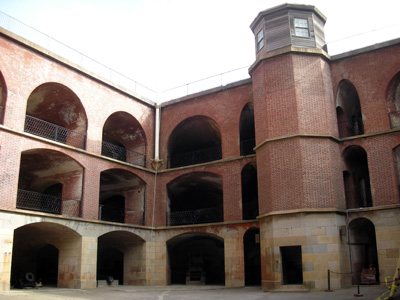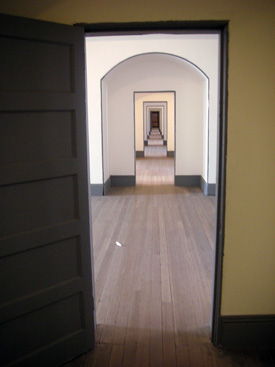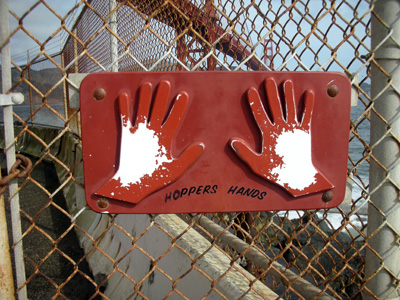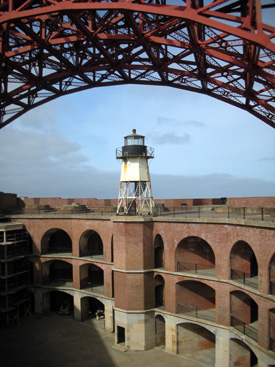
Fort Point hides under Golden Gate Bridge
SAN FRANCISCO— Nestled underneath the Golden Gate bridge, sheltered from the traffic and the tourists’ flash bulbs, stands the coliseum-shaped skeleton of an abandoned military outpost.
“There’s definitively an eerie quality,” said Janice Parra, a first-time visitor to Fort Point National Historic Site, part of the Golden Gate National Recreation Area. “It looks slightly dilapidated, but you start to get the impression that it was like this even back in its heyday; cloaking in fog, bare and quiet, with only the sound of the waves and the lighthouse.”
 |
Part of the Presidio at Fort Point National Historic Site (Photo by Fatima Reynolds). |
Fort Point is located at the southern side of the Straits of the Golden Gate, at the entrance to San Francisco Bay. It stood as the only coastal defense site of its kind on the West Coast, as opposed to the more than 30 on the East Coast.
Construction began on the site in 1853, shortly after California became part of the United States.
U.S. Secretary of War C.M. Conrad and Chief of Engineers Gen. J.G. Totten appealed to Congress for funds to fortify the Pacific Coast, asserting that the naval powers of Europe had increased the caliber of guns on their warships.
In 1851, a board of engineer officers drew up plans for the defense of San Francisco Bay, recommending forts at Golden Gate and Alcatraz Island. The seven-foot thick walls and multi-tiered casemated construction of Fort Point were complete in 1861, and cost approximately $2.8 million.
In 1861, the first troops were ordered to the site and the Army mounted the fort’s first cannon, as Bay Area defenses were preparing for the looming war. By 1863, cannons at Fort Point could sink any wooden ship that came within two miles.
Ed Barry, a tour guide at the Fort and a ranger for the recreation area, said that throughout the Civil War, “artillerymen stood guard for an enemy that never materialized.” He said that in August of 1865, a Confederate ship was on its way to attack San Francisco, but before reaching Fort Point, the captain learned the war had ended.
| Interior doorways at Fort Point (Photo by Fatima Reynolds). |
 |
Following the war, troops vacated the fort, and it was never again continuously occupied by the Army. Instead, used over the next four decades for barracks, training, and storage. Soldiers were stationed there during World War II to guard minefields and the anti-submarine net that spanned the Golden Gate.
In the 1930s, the fort risked removal in the face of ambitious plans for the Golden Gate Bridge. But Joseph Strauss, the chief engineer, redesigned the bridge to save the site. Today, Fort Point is situated directly below the southern approach to the bridge, underneath an arch that supports the roadway.
Visiting the oft-ignored site can be an interesting exploit. Its isolated location and long, desolate corridors create the feeling that one is venturing into an old haunted house or exploring long-forgotten ruins.
 |
The red pair of hands known as “Hopper’s Hands honor a man who once ran at Fort Point (Photo by Fatima Reynolds). |
Sightseers can bask in the scenic vistas overlooking the Bay and enjoy picturesque network of buildings, on the five to 10 minute walk from the “Warming Hut” at the base of the Presidio.
Those in an active mood should jog down and observe a pair of red hands on the side of Fort Point that many runners in this area make sure to touch before turning around and going back.
John Davies, one of the runners informed me that these hands labeled “Hopper’s Hands” were placed there in memory of a man and his dog that ran the stretch every day.
“It was before my time, but I think it’s still good luck,” said Davies.
Doors at Fort Point open at 10 a.m. and an introductory movie is screened at 10:30. Visitors should begin their tour starting at the stairwell to the right of the screening room.
Walk through the precisely aligned doorways through Surgeon’s and Officer’s quarters and Mess Hall, to the Women at war and lighthouse exhibits. The lighthouse room is especially interesting, as you get to read about shipwrecks and the lives of lighthouse keepers. The keeper with the longest tenure, 41 years, was named James Rankin.
My guide at Fort Point, Ed Barry, said that one of Rankin’s best known rescues was a couple who had been drinking wine and dancing on the sea wall. They fell into the surf and were being carried out to sea on the tide. Rankin stripped off his clothes to swim out and save the couple, to which the woman screamed: “I’ve never seen a naked man in my life except my husband!”
Treacherous tidal currents, strong winds, prevalent fog, and submerged rocks led to frequent shipwrecks in the waters just off Fort Point. Three lighthouses have stood at the Fort, punctuated by demolition and construction activities. The third, which ceased operation in 1934, still stands today.
Visitors should then make their way up the staircase to the roof. The lighthouse is nestled underneath an archway; however it is closed to the public as it is no longer maintained. Strolling along the roof, one can imagine the cannons and their artillerymen poised and ready for anything.
In the 1880s, the muzzle-loading guns of San Francisco were replaced with seacoast rifles capable of firing huge projectiles more than 25 miles. Ultimately, the defense system abandoned in 1946 after 48 years and without having ever fired a shot.
| Fort Point and Golden Gate National Recreation Area offer scenic views for visitors (Photo by Fatima Reynolds). |
 |
While never coming under enemy fire, this relic has weathered fierce winter storms, high winds and seas.
Wind around the roof to the opposite stairwell, returning to the first floor. Enter the Powder Magazine, where gunpowder and other supplies were stored. On the first and second floors, there are parts of the wall that were demolished.
In 1913, work began to convert Fort Point into a detention barracks, as Alcatraz Island was turned over to the U.S. Dept. of Labor for use by the Bureau of Immigration and Naturalization. Soldier prisoners at Alcatraz were to be sent to Fort Point.
At noon and periodically throughout the day, there are cannon demonstrations and screenings of various movies, including one chronicling construction of the Golden Gate Bridge.
Leaving the site, one can hike about 15 minutes up the stairs on the face of the cliff towards the Bridge. There is a small visitor center and a bus stop. Buses travel to downtown, Haight Street or other areas of Golden Gate National Recreation Area
While never coming under enemy fire, this relic has weathered fierce winter storms, high winds and seas. It is a sight to behold in all of its eerie glory.
If You Go
Getting There:
- Fort Point is on the southern anchorage of the Golden Gate Bridge, on the edge of the bay.
- It is at the end of Marine Drive on the Presidio of San Francisco.
- By car take Highway 101 north and exit right at the Golden Gate Bridge toll plaza before getting on bridge. Turn right at end of exit ramp and then left onto Lincoln Boulevard. Take the first left onto Long Avenue and follow onto Marine Drive and Fort Point at its end.
- By public transit, San Francisco Muni 28 and 29 bus routes stop at bridge toll plaza. Follow trail signs northeast of plaza area to Fort Point at base of bluffs.
Admission and Hours
- Entrance is free
- Friday, Saturday and Sunday 10 a.m. to 5 p.m.
Phones
- Public Information 415-556-1693
- Bookstore 415-673-5642
Ranger Station
- The Fort Point Ranger Station is located at the cross streets of Long Avenue and Marine Drive just off of Lincoln Boulevard, at the Presidio of San Francisco. West of the Warming Hut.
Available Facilities
- Restrooms are available outside of Fort Point. They are located approximately 100 yards away from the fort, down the main road on the right side.

Comments are Closed